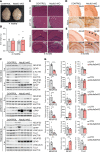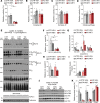Metformin delays neurological symptom onset in a mouse model of neuronal complex I deficiency
- PMID: 33148885
- PMCID: PMC7710273
- DOI: 10.1172/jci.insight.141183
Metformin delays neurological symptom onset in a mouse model of neuronal complex I deficiency
Abstract
Complex I (also known as NADH-ubiquinone oxidoreductase) deficiency is the most frequent mitochondrial disorder present in childhood. NADH-ubiquinone oxidoreductase iron-sulfur protein 3 (NDUFS3) is a catalytic subunit of the mitochondrial complex I; NDUFS3 is conserved from bacteria and essential for complex I function. Mutations affecting complex I, including in the Ndufs3 gene, cause fatal neurodegenerative diseases, such as Leigh syndrome. No treatment is available for these conditions. We developed and performed a detailed molecular characterization of a neuron-specific Ndufs3 conditional KO mouse model. We showed that deletion of Ndufs3 in forebrain neurons reduced complex I activity, altered brain energy metabolism, and increased locomotor activity with impaired motor coordination, balance, and stereotyped behavior. Metabolomics analyses showed an increase of glycolysis intermediates, suggesting an adaptive response to the complex I defect. Administration of metformin to these mice delayed the onset of the neurological symptoms but not of neuronal loss. This improvement was likely related to enhancement of glucose uptake and utilization, which are known effects of metformin in the brain. Despite reports that metformin inhibits complex I activity, our findings did not show worsening a complex I defect nor increases in lactic acid, suggesting that metformin should be further evaluated for use in patients with mitochondrial encephalopathies.
Keywords: Genetics; Mitochondria; Mouse models.
Conflict of interest statement
Figures







Similar articles
-
Myopathy reversion in mice after restauration of mitochondrial complex I.EMBO Mol Med. 2020 Feb 7;12(2):e10674. doi: 10.15252/emmm.201910674. Epub 2020 Jan 9. EMBO Mol Med. 2020. PMID: 31916679 Free PMC article.
-
Mutant NDUFS3 subunit of mitochondrial complex I causes Leigh syndrome.J Med Genet. 2004 Jan;41(1):14-7. doi: 10.1136/jmg.2003.014316. J Med Genet. 2004. PMID: 14729820 Free PMC article.
-
Post onset, oral rapamycin treatment delays development of mitochondrial encephalopathy only at supramaximal doses.Neuropharmacology. 2017 May 1;117:74-84. doi: 10.1016/j.neuropharm.2017.01.039. Epub 2017 Feb 1. Neuropharmacology. 2017. PMID: 28161373
-
[Ubiquinone: metabolism and functions. Ubiquinone deficiency and its implication in mitochondrial encephalopathies. Treatment with ubiquinone].Rev Neurol. 1999 Jul 1-15;29(1):59-63. Rev Neurol. 1999. PMID: 10528314 Review. Spanish.
-
Mitochondrial complex I deficiency of nuclear origin I. Structural genes.Mol Genet Metab. 2012 Feb;105(2):163-72. doi: 10.1016/j.ymgme.2011.11.188. Epub 2011 Nov 18. Mol Genet Metab. 2012. PMID: 22142868 Review.
Cited by
-
ATAD3A has a scaffolding role regulating mitochondria inner membrane structure and protein assembly.Cell Rep. 2021 Dec 21;37(12):110139. doi: 10.1016/j.celrep.2021.110139. Cell Rep. 2021. PMID: 34936866 Free PMC article.
-
Restoration of defective oxidative phosphorylation to a subset of neurons prevents mitochondrial encephalopathy.EMBO Mol Med. 2024 Sep;16(9):2210-2232. doi: 10.1038/s44321-024-00111-4. Epub 2024 Aug 21. EMBO Mol Med. 2024. PMID: 39169163 Free PMC article.
-
Metformin Lysosomal Targeting: A Novel Aspect to Be Investigated for Metformin Repurposing in Neurodegenerative Diseases?Int J Mol Sci. 2024 Aug 15;25(16):8884. doi: 10.3390/ijms25168884. Int J Mol Sci. 2024. PMID: 39201569 Free PMC article. Review.
-
Disease models of Leigh syndrome: From yeast to organoids.J Inherit Metab Dis. 2024 Nov;47(6):1292-1321. doi: 10.1002/jimd.12804. Epub 2024 Oct 9. J Inherit Metab Dis. 2024. PMID: 39385390 Free PMC article. Review.
-
NDUFS3 promotes proliferation via glucose metabolism reprogramming inducing AMPK phosphorylating PRPS1 to increase the purine nucleotide synthesis in melanoma.Cell Death Differ. 2025 May 22. doi: 10.1038/s41418-025-01525-4. Online ahead of print. Cell Death Differ. 2025. PMID: 40404919
References
-
- Wirth C, Brandt U, Hunte C, Zickermann V. Structure and function of mitochondrial complex I. Biochim Biophys Acta. 2016;1857(7):902–914. - PubMed
-
- Koopman WJ, et al. Mammalian mitochondrial complex I: biogenesis, regulation, and reactive oxygen species generation. Antioxid Redox Signal. 2010;12(12):1431–1470. - PubMed
Publication types
MeSH terms
Substances
Supplementary concepts
Grants and funding
LinkOut - more resources
Full Text Sources
Medical
Molecular Biology Databases
Research Materials
Miscellaneous

